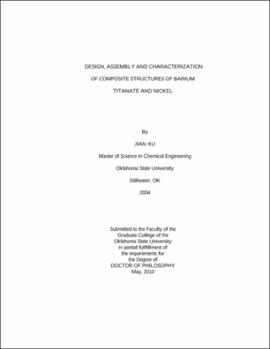| dc.contributor.advisor | Smay, James E. | |
| dc.contributor.author | Xu, Jian | |
| dc.date.accessioned | 2013-11-26T08:31:43Z | |
| dc.date.available | 2013-11-26T08:31:43Z | |
| dc.date.issued | 2010-05 | |
| dc.identifier.uri | https://hdl.handle.net/11244/7175 | |
| dc.description.abstract | Scope and Method of Study: Three dimensional, heterogeneous, geometrically complex ceramic-metal composite structures are fabricated by assembly of aqueous colloidal gels of barium titanate and nickel, followed by densification of ensembles in controlled atmosphere through sintering. This work focuses on the processing of colloidal gels, assembly of the composite structures, and co-sintering of composite structures. Relevant sintered material properties including oxidation, hardness, microstructure, and electric properties are characterized. Specifically, rheological characterizations are used to determined colloidal gel formulations; sintering shrinkage is used as a function of temperature to determined compatible gel compositions; thermogravimetric analysis is used to characterize thermal degradation and oxidation of polymer additives and carbon black support material, respectively. | |
| dc.description.abstract | Findings and Conclusions: The findings of this study are four folds: 1) a carbon black gel may be used as fugitive materials for assembly of geometrically complex objects; 2) a nickel gel may be used to assemble objects that have >99% density; 3) barium titanate and nickel composite structures that have a low solid volume fraction of nickel may be assembled and consolidated through solid state sintering, and 4) barium titanate and nickel composite structures that have a high solid volume fraction of nickel may be assembled and consolidated through liquid phase sintering. The use of small additions of sintering aids allows successful densification of composite structures that have discrete interface, heterogeneous composition, and intricate geometric design. Low internal stress and plastic deformation of particle network during liquid phase sintering process facilitate the co-sintering of dislike ceramic and metal materials. | |
| dc.format | application/pdf | |
| dc.language | en_US | |
| dc.rights | Copyright is held by the author who has granted the Oklahoma State University Library the non-exclusive right to share this material in its institutional repository. Contact Digital Library Services at lib-dls@okstate.edu or 405-744-9161 for the permission policy on the use, reproduction or distribution of this material. | |
| dc.title | Design, assembly and characterization of composite structures of barium titanate and nickel | |
| dc.contributor.committeeMember | Rhinehart, R. Russell | |
| dc.contributor.committeeMember | Johannes, A. J. | |
| dc.contributor.committeeMember | High, Martin S. | |
| dc.contributor.committeeMember | Hanan, Jay C. | |
| osu.filename | Xu_okstate_0664D_10898.pdf | |
| osu.accesstype | Open Access | |
| dc.type.genre | Dissertation | |
| dc.type.material | Text | |
| dc.subject.keywords | barium titanate | |
| dc.subject.keywords | carbon black | |
| dc.subject.keywords | freeform fabrication | |
| dc.subject.keywords | nickel | |
| dc.subject.keywords | robocasting | |
| dc.subject.keywords | sintering | |
| thesis.degree.discipline | Chemical Engineering | |
| thesis.degree.grantor | Oklahoma State University | |
